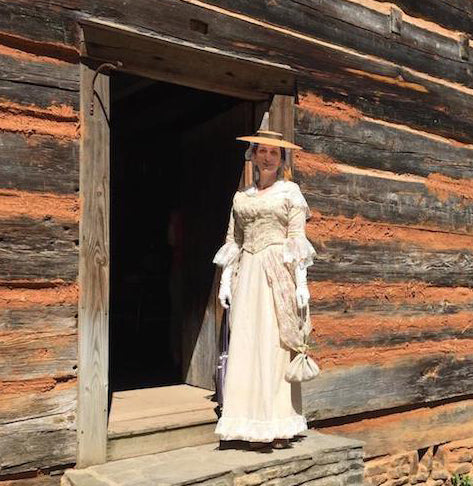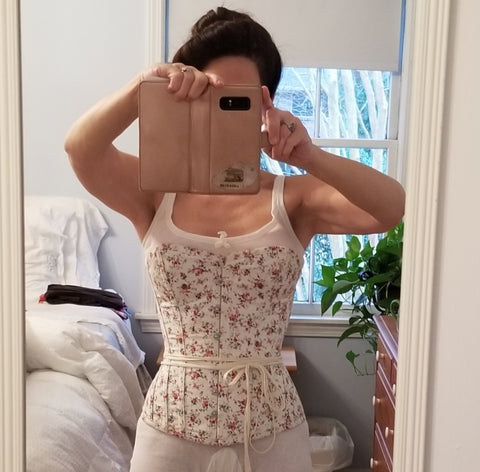
Time Warp... and Weft (Part 2)
In a previous post I considered how costumers play fast and loose with history, imbuing designs with modern touches to appeal to their current audience. Whether striving for a twist on historicity or just doing as they please, in these cases the results are intentional.
Do you agree that sometimes, though, the anachronisms we see in costuming -- whether by a wardrobe-department pro, a museum docent, or an amateur reenactor -- may not be quite so... calculated?
There is something about our own time that mires us in it, making it impossible to fully embody or recreate times past -- even relatively recent times. And even when we give it our best effort.
It goes beyond clothes, of course. Hairstyle, makeup, grooming, accessories, even posture, deportment, and expression can be giveaways*.
We move through the world as modern people. We are shaped by our daily experience, both literally and figuratively, and it is difficult, if not impossible, to transform ourselves completely. This was as true for those playing dress-up 150 years ago as it is for us today.
Last year, my family attended a living history event at Fort Yargo State Park.
 That's the actual color of the "red Georgia clay" between the logs.
That's the actual color of the "red Georgia clay" between the logs.
The fort was built in 1793 and the event focused on daily life at that time. No way I was showing up in modern clothes.
But I had only one option, this 19th century dress I'd bought from an online seller. Forgive the tiny image, it's the only pre-modification one I've got.

I'd given it the usual going over -- repairs, reinforcing, and then into the wash. As is typical of cotton antique clothing, it came out fine. I added new engageantes (ruffly cuffs) over the remnants of the delicate originals. I also added a matching ruffle at the hem to conceal stains (looks tacky, I'll remove and possibly replace it).
The dress was meant to resemble an 18th century robe à la polonaise such as this one:
 French, 1775 (LACMA via Wikimedia)
French, 1775 (LACMA via Wikimedia)
The U.S. Centennial of 1876 brought back styles popular 100 years prior, and the Bo-Peep shepherdess look was once again trendy. The style had come and gone a few times already, and would do so again.

Marie Antoinette [center] at Petit Trianon Playing at Being
a Shepherdess, by Charles Delort (1841-1895)
My dress is nearly 150 years old. It is definitely antique. But it's not 18th century, it's the 1876 revival version.
 Playing dress-up for the Fort Yargo 18th century event.
Playing dress-up for the Fort Yargo 18th century event.And if you can't tell that just by looking at it, here's what gives it away:
1. The construction is all wrong. On a real robe a la polonaise, the drapery at the sides and back are part of the dress -- the robe -- itself. It's made as a fitted bodice with an attached skirt that's split at the front -- like a dressing gown or bathrobe, thus, "robe." The skirt could be worn loose and long, or lifted up into side poofs "a la polonaise" via internal rigging (basically a couple sets of ribbons).
The robe went over the "petticoat" which, confusingly, was not an undergarment, but what we'd now call a skirt (the solid green part of the ensemble in the LACMA image, above -- it's just a skirt and it goes all the way around).

My centennial costume, drying on the line.
As you can see, the drapes of floral fabric on my dress are phony in that they're just extra pieces formed into swoops and permanently affixed at the skirt's waistband. There's also a long, free-hanging piece. This is doubly odd.
My polonaise dress is about as far from an original, in both age and construction, as these real and revival Edwardian dresses:
 L: Original Edwardian dress purchased at EaDo Vintage.
L: Original Edwardian dress purchased at EaDo Vintage.
R: Edwardian revival 1970s dress available at BDV.
2. The shape is all wrong. My dress has the curvy, boned, waist-length bodice of a typical bustle-era dress. And even though I could close the bodice without a corset, when I put on my reproduction 18th century stays, I couldn't. Not even close. The 18th century corset rearranged me into the wrong shape.
 Repro 18th Century stays by Historical Designs
Repro 18th Century stays by Historical Designs
When I switched to my reproduction Victorian corset, the dress fit perfectly. Compare the curvy, Coke-bottle shape below to the flattened ice cream cone shape, above. The one below emphasizes the waist. The one above does not.
Most modern clothing conforms to fit us regardless of what we wear (or don't) underneath. It's often stretchy and forgiving. But the silhouettes of earlier times demanded specific foundation garments -- and not just to create the desired silhouette.
This was true even up to the mid-1960s. Many women still wore waist cinchers and other figure-refining undergarments not simply to smooth out lumps and bumps, as Spanx and similar shapers do, but to fit into the clothes at all.
Even from afar -- without scrutinizing the construction or knowing what textiles were available and popular at the time -- someone with an interest in historic dress can see that my dress is the wrong shape. This alone is convincing evidence that it isn't 18th century.
Up close, more clues told me it wasn't from 1926 or 1976, either (both had seen similar patriotically inspired style revivals). No. It was a Victorian dress. No doubt about it.
Was it the weave of the fabrics? The pattern of the floral print? The way the seams and hems were finished? The way it was lined? All of these, sure. But there's something more. Is it meaningless to talk about the overall feel of the thing? I don't think so. And while I'm not expert enough to fully define each point that tells me "1876," in the end, yes, I could "just tell."
I suspect that whoever made my dress did her best to approximate the look of the 1770s. But she couldn't transcend her own time. She sewed it as she'd sew her modern clothing, and fit it to her body shaped not only by her modern-day corset but by a lifetime of standing and moving, and being, a person of her own time.
Without being aware of it and with little ability to do anything about it, we inject into our creations the time in which we live. Sometimes a little, sometimes a lot. But even if it's just the subtlest of suggestions, it's there -- that indefinable something that makes an object, a person, an image, "of its time."
Can you tell when these two faux-18th century, Marie Antoinette costume patterns are from? I'd bet you can, even with the fonts and other packaging clues concealed. Just in case, the answers are provided below***:

How about this shepherdess ensemble? Can you Guess the Date?****:

What does all this mean for the average vintage lover scouring the internet or local shops for treasure of a certain age? What if you can't (yet) rely on your own fashion-dating expertise?
For some buyers, it's not an issue. They care only about the look of the thing. If they like what they see, the seller's expertise (and honesty) regarding its vintage isn't of concern.
But for those who do care, there are ways to avoid being deliberately or unintentionally misled. The first step is to do your own homework. Even well-meaning sellers -- and I'd say that the vast majority of sellers are fundamentally honest and don't intend to mislead -- can be wrong.
I'll be writing up a vintage reference sheet to help you identify and date your finds. For now, my advice is to be inquisitive and do your research. Never hesitate to ask a seller how they dated their item -- they'll often admit they're trusting the word of the previous owner. Shopping online? You can always ask for additional images or information. No reputable dealer will be offended or annoyed.
If there's a label, check online vintage label encyclopedias and/or do a search on the company's history and trademark. A 1920s dress wasn't made by a company founded in the 1940s, no matter what the seller tells you. Similarly, you can't create a garment from fabrics not yet made, using technology not yet invented (that blouse with polyester lace is 1970s, not 1910s). Time, outside the TARDIS and our dreams, only goes in one direction.
Finally, to familiarize yourself with the overall look and feel of your favorite era, refer to original sources such as fashion plates, reputable museums' images, and advertisements from the time in question. And read, read, read.

* Descendants of today's young adults will see Grandma's tight leggings, multiple tattoos, and highly styled eyebrows and say, "Ha! 2010s." Those duckface selfies will one day -- for better or worse -- help date photos.
** Seller had listed the dress correctly as 1870s.
*** Vintage patterns are from the 1930s (L) and 1950s (R).
**** Shepherdess Guess the Date answer: 1890s 
Comments
Great post! Reminds me of some things that have been discussed on the Frock Flicks blog – like so often you’ll see a costume film and you know in what decade it was made because of the style of the costumes, hair, make-up, whatever, no matter how accurate they tried to be.
